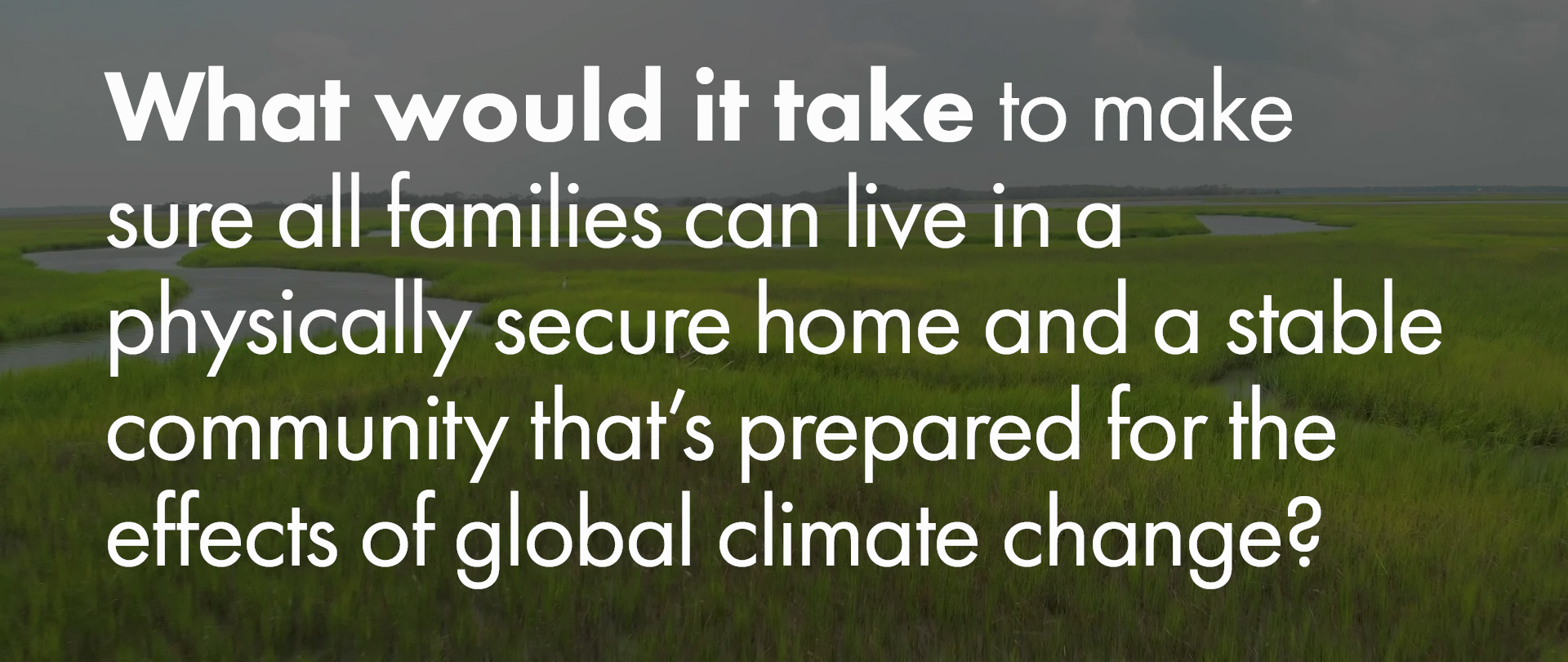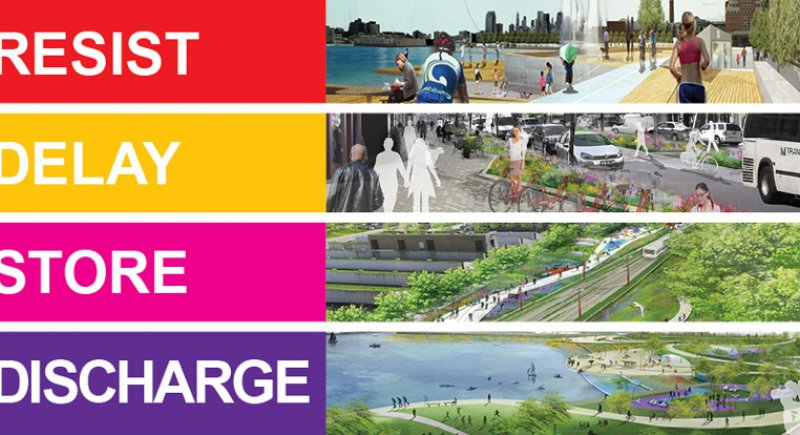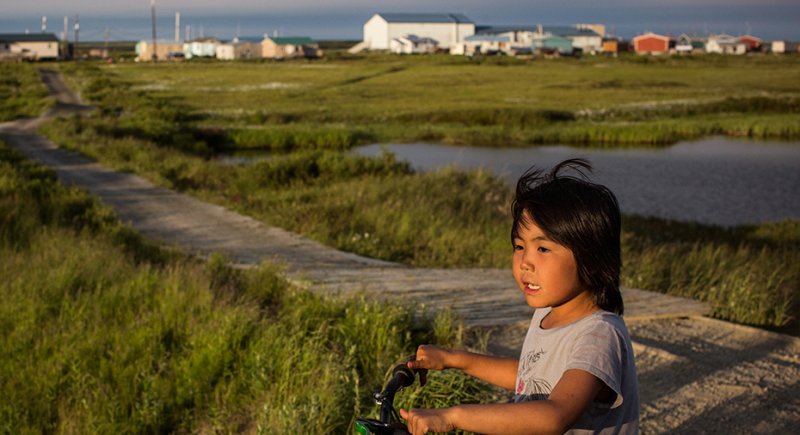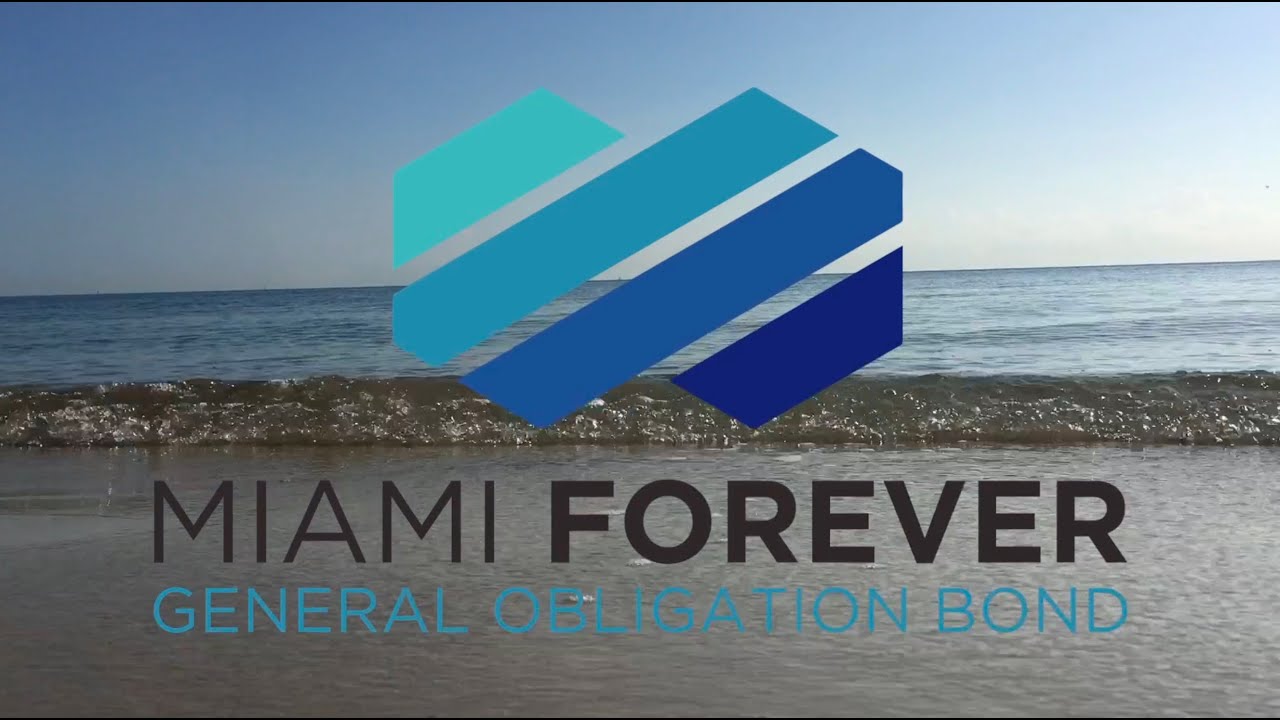
We envision a future where families and communities can effectively prepare for the disruptive effects of global climate change. These preparations would give everyone the information and the agency they need to decide how best to adapt to the consequences of our changing climate. They would protect communities’ historical assets and social networks. And they would provide opportunities for both individual and collective actions that promote equity while addressing past injustices.
Our climate is inexorably changing. Around the world, more frequent and severe weather events, rising sea levels, more vector-borne diseases, and higher temperatures are increasingly disrupting people’s lives. Reshaping how they live. Transforming where they live. For communities built decades ago, climate change is presenting unprecedented challenges; for areas that continue to grow, it’s posing new risks of harm.
Over the past three decades, US advocacy and policy have emphasized climate mitigation—that is, curbing further climate change by reducing greenhouse gas emissions through our use of fossil fuels. This is an essential project for humanity. Our commitment to equity demands it as well, since lower-income communities and communities of color will be those most affected by our warming planet.
But we can’t afford to neglect climate adaption—strategies to help people and communities prepare for and adjust to the effects of climate change. And these efforts must focus special attention on supporting underresourced communities, so climate doesn’t become another force that hardens and extends social and economic inequities. Today, American communities trail others around the globe in preparing for climate change’s effects—and they are likely to experience greater pains to catch up. We are optimistic, however, that the United States is up to the challenge.
Climate Adaptation: Promising Solutions
Here’s the reality: Only a few solutions for adapting to climate change are being pursued in the US. Among them, even fewer address historical inequities or the disparate outcomes adaptation decisions can have for families and communities. Still, innovative and inspiring solutions bubbling up across the country could support equitable action in response to current and future effects of climate change.
- Some of these solutions extend existing tools to temper the earliest disruptions from climate change,
- more ambitious ones defend against climate’s effects with major reforms to land use and infrastructure, and
- the most radical ones enable communities to relocate to safer ground.
Essential to all these solutions are inclusive engagement and decisionmaking that ensure all voices are heard and all communities are protected. So that is where we begin.
“We have to be able to get past the bias and assumptions we make about people to create space to see their humanity and the humanity of the entire community and to see the shared struggles and hopes as being related to our own.”
Embrace inclusive decisionmaking
People who live in underresourced communities typically have the least access to information and less capacity to participate in climate preparation and planning. They often are not even invited to be part of the decisionmaking processes that shape where they live. Families who are struggling financially, the elderly and physically challenged, and people of color are less likely to be prepared for climate effects. Instead, they are more likely to suffer significant losses from climate events and face a tougher path toward recovery. A growing number of influencers across the country are keen to shift this trajectory by designing public engagement strategies to reach people and communities that have been overlooked and ensure their voices are heard.
Among the solutions underway that promote such equity and inclusivity are
- educational campaigns and conversations about climate adaptation, such as those held by grassroots organizations like West Harlem Environmental Action Inc. in New York and the Gulf Coast Center for Law and Policy in Louisiana;
- climate health workshops like those sponsored by Seattle and King County’s public health department to raise awareness about the importance of health in climate adaptation planning;
- communications tools to help lay audiences understand the causes and effects of climate change, such as the “Climate Chat” developed by the Climate Advocacy Lab; and
- community climate adaptation plans, like the climate blueprint San Antonio’s Southwest Workers Union developed that was eventually included in the city’s formal planning effort, and Catalyst Miami’s community-led input on how to use revenues from the Miami Forever Bond.
These efforts move in the right direction by sharing accessible information and inviting input. As decisions become more and more consequential, the spirit of these models should be extended from input to real and effective participation in decisionmaking.
Extend existing tools to temper climate disruptions
Private-sector influencers and local, state, and federal governments are exploring ways to minimize the effects of global climate change on people’s lives in the near term.
Under the leadership of Mayor Francis Suarez, Miami is implementing the $400 million Miami Forever Bond to address increased flooding and sea-level rise.
“We’ve also got to take action to protect our state from the effects of climate change. The science is in, and it’s time we get to work to mitigate the impact of climate change for the sake of our kids and future generations in Michigan.”
Emerging ideas for alleviating climate-related upheaval include
- retrofitting homes to better protect them from disaster, and providing insurance discounts to homeowners that do, such as in Alabama’s fortified home program;
- promoting parametric insurance pools and cooperatives, which estimate property damage based on environmental benchmarks (like wind speeds) and issue payouts when those benchmarks are met, rather than delaying payouts until the actual damage can be assessed;
- scaling technical retrofits of existing infrastructure, such as Miami Beach’s effort to elevate major roads and install new water pumps to remove increased loads from sea-level rise as well as storm water system billing reforms in Philadelphia and Washington, DC, aimed at reducing harmful runoff;
- coordinating actions across government agencies—especially emergency management services, housing, and food assistance—in the aftermath of climate events, along with community and economic development investments to provide the rudiments of a “climate safety net,” as is being done in California and Memphis; and
- issuing climate-specific bonds—often called green or resilient bonds—to finance infrastructure improvements, like those that voters enthusiastically approved in San Francisco, Houston, and Miami.

Rebuild by Design’s innovative projects throughout the New York City area—including in Hoboken, New Jersey—focus on defensive infrastructure, such as using hard infrastructure and soft landscape as barriers (resist); green infrastructure to slow runoff (delay); green roofs and adaptations to capture water (store); and enhancing the city’s storm water management system to manage flooding (discharge).
Reform land uses and infrastructure
As cities and towns make physical preparations for the expected effects of hurricanes, tornadoes, wildfires, and “sunny day” floods, they are exploring more fundamental reforms to land use, building techniques, and property rights that respond adaptively to climate change’s increasing effects. Promising solutions are being explored in
- New Orleans, where the city is using innovative approaches to water and land management to help families in Gentilly and other neighborhoods adapt to a changing climate and improve their health, economic opportunity, and environmental education;
- Hoboken, where the planned Hudson River Project coordinates with neighboring municipalities to store excess flood water in bioretention infrastructure tied to the cities’ storm water drainage and combines with urban green infrastructure like recreational berms; and
- Phoenix, where a major tree-planting initiative aims to reduce the city’s heat island effect (a climate mitigation action) while providing shade to reduce ambient temperatures on the street.
And new regional governance models are emerging, such as the Southeast Florida Regional Climate Change Compact and Bay Area Climate Adaptation Network, since climate effects don’t respect jurisdictional boundaries.
Other innovative place-based responses to rising sea levels include mass elevation; conversions to water-based transport, such as navigable canals; and aquatic architecture. None of these, however, is taking place in the US.
Relocate to safer ground
As climate events become more frequent and damaging, some families may choose to move to safer places, and property buyouts will likely become more common. So will decisions to relocate entire communities to safer ground. We expect that these bold solutions will ultimately occur in deserts as well as low-lying coastal and river communities. The only communitywide relocations in the US are under way in
- Isle de Jean Charles, Louisiana, and Newtok, Alaska, which received federal funding to relocate their residents in 2016 and 2018, respectively (though relocation funds for several other Alaska Native villages are under consideration).

“The relocation effort has not been very easy, especially the part related to trying to raise sufficient funds to make it happen … With climate change taking place and especially as it is impacting our community today, we are working very hard to make it happen.”
– Paul Charles, President of Newtok Village Council
Climate Adaptation: Knowledge Priorities
What follows are seven areas where climate change innovators from diverse sectors need more information and evidence to advance solutions that help communities and families adapt to the effects of climate change—without further exacerbating inequalities.
Assess the need for a climate safety net
The brunt of long-term uninsured financial, health, and property shocks will be shouldered by families with lower incomes; this is as true for climate-related disasters and as it is for climate’s chronic effects. Programs and services that provide a safety net for the most vulnerable are works in progress. Such efforts, like housing assistance, health insurance, and disaster recovery services, are often only offered during acute crises, like hurricanes, and not to help communities respond to chronic issues, like rising sea levels.
Federal policymakers need better evidence about how today’s safety net programs (like TANF, SNAP, the EITC, and housing vouchers) interact and overlap with disaster recovery assistance. Then they can implement reforms that fill gaps and resolve redundancies—or, as risks rise, develop an entirely new approach to protecting families. Achieving this would mean
- examining previous safety net program expenditures and the types of assistance delivered after major disasters over time;
- evaluating the impact, costs, and benefits of climate-related public assistance on families and communities; and
- applying microsimulation tools to test scenarios involving various climate effects, demographic groups, geographic areas, and assistance programs to determine the appropriate mix of services the federal government could employ under its current disaster authorities.
“I think the issue is what motivates people ... All the levers are different.”
Understand people’s perceptions and behaviors
Historically, individuals and families have decided how they want to adapt to the effects of climate change, including where to live, whether to invest in hazard insurance, or how to navigate their transforming environment (like choosing alternative transit routes during “sunny day” floods). To identify and implement the most effective techniques for educating people, shifting their behaviors, and helping them make informed decisions about their risks, local policymakers, planners, advocates, and businesses need to know more about how people choose to prepare for climate effects and how they respond to educational campaigns, incentives, regulations, and immediate environmental hazards. This would call for
- engaging diverse experts, including behavioral economists and psychologists, to pilot interventions among diverse communities to learn what strategies effectively shift people’s behaviors; and
- linking historical data from both public and private sources to analyze and model behavioral responses to hazards and to preventive and adaptive actions (such as hazard insurance, housing choices, community participation events).
“Communities do have the solutions but, when it comes to planning, those voices are usually not included.”
Measure inclusive engagement and equitable outcomes
Many local officials and community leaders struggle with how, when, and who should be involved in local decisions about how climate change impacts people and communities. Many want to design better strategies to effectively engage individuals and families in planning processes, empower them to elevate their voices and experiences, and measure the outcomes, but they don’t know how. To help accelerate their progress and develop clear best practices would require
- evaluating the language and formats of current climate planning engagement activities and collecting data on people’s participation to understand how efforts differ from practices in other areas, such as regular commercial or residential developments in cities;
- defining how to identify the most vulnerable people in a community and how to integrate historical inequities into those definitions;
- assessing whether engagement strategies need to be tailored for certain neighborhoods and cultures; and
- determining how local elected leaders’ term limits affect the public sector’s willingness to engage in long-term planning and community engagement.
Assess local capacity and leadership
State and local leaders want to know how to build and strengthen their local institutions’ capacity to develop and implement equitable climate adaptation strategies. Creating capacity and incentives for equitable strategies is particularly difficult in poorer communities that have lower revenues and higher risks. It’s also true in places where leaders face term limits and are unlikely to be around to witness the fruits of their work.
“There are communities that are unjustly disproportionately affected along lines of race and class. Underlying systems and processes foster the impacts that strip away the resilience, well-being and dignity of Black, Brown, and poor people. In the next 50 years, it is critical to position those most impacted by climate change [to] have the power to design, own and determine the solutions and outcomes necessary to tackle the impacts. The impacts have dire and immediate consequences for these communities, making them more vested in moving solutions with urgency.”
To help build knowledge and identify best practices would require
- assessing existing components of local governments’ climate-related capacity by, for example, examining bond ratings against climate risks, which could help determine which communities are least able to address the greatest risks;
- gathering data on local communities’ expenditures and staffing in various governmental and nonprofit roles, to understand communities’ capacity to develop climate adaptation strategies; and
- testing these measures to determine if they can strengthen local capacity and leadership.
“Climate change poses challenges to a legal system that assumed nature was basically static. Local governments should be proactive in understanding how property, land use and other laws can achieve or derail their desired policy directions.”
Evaluate governance and property laws
So much of our built environment was developed before awareness of the risks associated with climate change, and it is governed by land use regulations that did not anticipate those risks. In addition, the effects of climate change spill across jurisdictions. As a result, our constitutional and legal frameworks for addressing large-scale environmental change are inadequate. Local leaders need to know much more precisely how land use regulations constrain climate adaptation decisions and what changes could spur more resilient development. And they need evidence-based models for regional decisionmaking and action.
Developing new regional governance strategies and more effective land use regulation would require
- launching comparative studies on land use laws and reform strategies;
- evaluating how local regulations affect property values, insurance coverage, and more;
- defining the necessary intragovernmental networks and functions that need to be employed to ensure appropriate and efficient public-sector action; and
- assessing the effectiveness of emerging governance models.
Share evidence about climate risks to specific people and places
To help families and communities best prepare for the consequences of climate change, local officials and community leaders need to first know the risks associated with multiple climate scenarios and their implications for people and places, then share that knowledge in ways that are accessible to wide audiences. Leaders also need to better understand the less-recognized effects of climate events—particularly on often-forgotten communities—such as poor air quality from manufacturing sites or few emergency facilities like cooling shelters. Achieving this knowledge would require
- modeling how various risks associated with climate change affect different demographic groups, thereby highlighting which risks pose disparate challenges and how;
- revealing the less-studied but equally impactful effects of climate change (such as air quality changes) and the people who are vulnerable to them in the same communities where the more known effects (such as sea-level rise) are playing out; and
- developing strategies for sharing evidence about risks that help people make informed choices.
Develop tools for calculating value
Public- and private-sector decisionmakers need tools to help them compare the full costs and benefits of climate adaptation strategies so they can make effective choices between competing alternatives. And these tools should equitably value the assets of historically disadvantaged communities and households so their interests aren’t neglected.
“When you ask people to prepare for climate change, they are making a financial decision. If they can’t afford to leave, they have to put themselves at risk. How do we create financial safety nets for them when bad things happen? I’m confident with better data, technology, and computational power the insurance industry will soon be able to address these challenges.”
Developing these tools will require
- studying the compensation and valuation for individual properties in a community, the indirect costs from inaction (such as employment reductions and heritage losses), and the collective value of a community in a region; and
- assessing the information local governments receive on the nature of future risks from climate effects and projecting the compensation to those risks.
Based on the Climate Adaptation Catalyst Brief, written by Carlos Martin and Olivia Arena.
